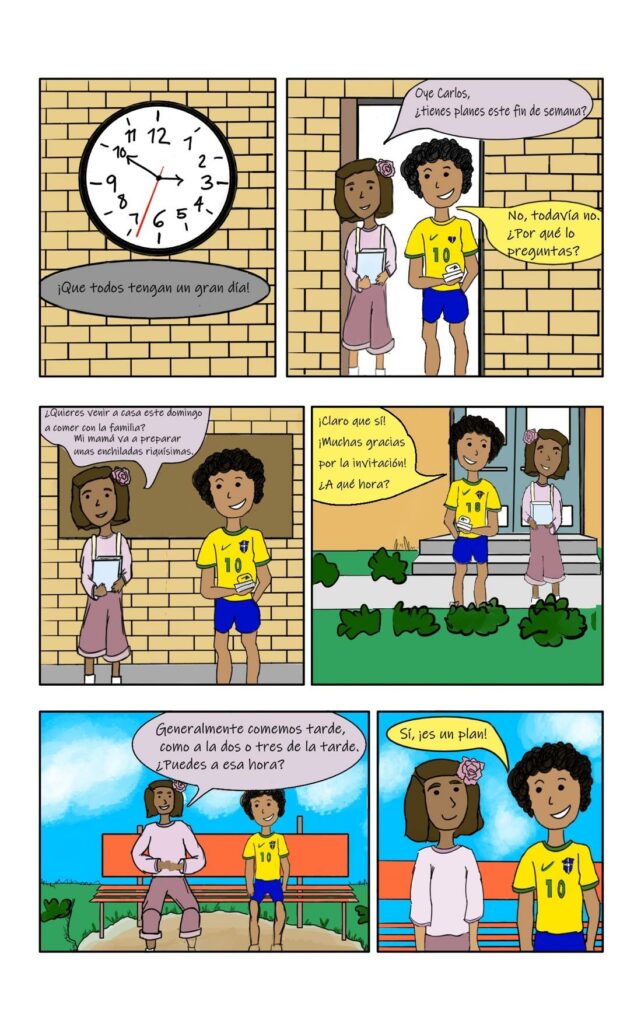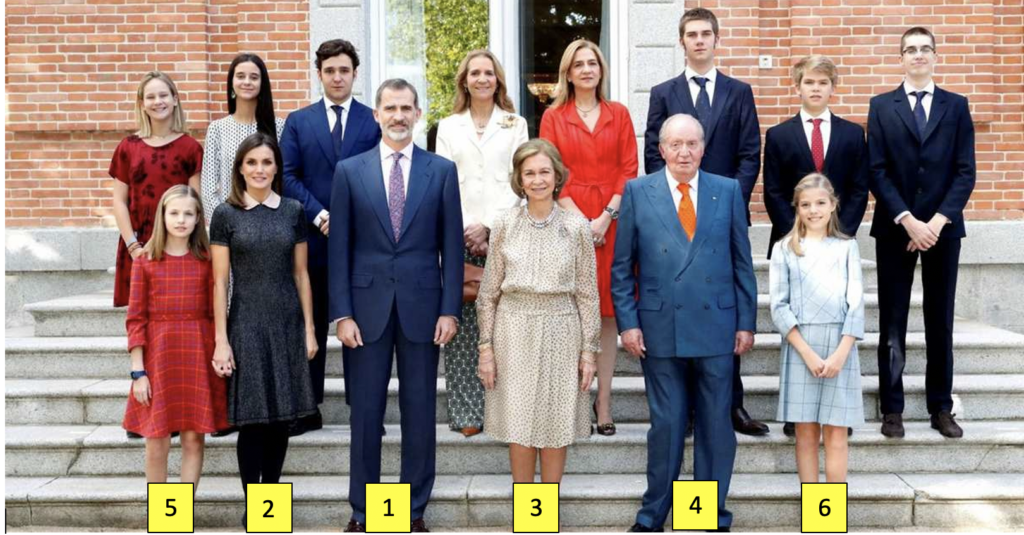3 Mi familia
Objectives
Communicative goals
- Describe families.
- Share feelings.
- Elaborate and clarify information by asking follow-up questions.
Cultural goals
- Compare and contrast the makeup of families.
- Review what families do when they spend time together.
- Explore the relative importance of families in different cultures.
I. Tira cómica
Ana invites Carlos to her home and introduces him to her family.

![Panel 1: The panel zooms in on Ana thinking. Carlos says, "Quiero llevar un regalo. Dime comó es tu familia." Ana says, "Bueno, pues..." Panel 2: The panels shows pictures of each of of Ana's family members. "Tengo una familia grande y maravillosa. En mi casa viven ocho personas: mi mamá [a woman with brown skin and brown hair in a bob], mi papá [a man with black hair with a black beard and mustache], mis tres hermanos [a college-age sister with pale skin and blonde hair covering one eye, a young boy with brown skin and curly black hair, and a tween boy with pale skin and dark brown hair. They are all smiling], mis abuelos [a man with gray hair, eyebrows, and mustache on his wrinkled face, and a woman wearing glasses with pale skin, wrinkles, and gray hair in a bun], y yo [shows a picture of Ana, with medium brown skin and brown hair, with a pink flower in it]." Carlos says, "¡Vaya! Mi familia es más pequeña. Solo somos mis padres y yo."](https://pressbooks.palni.org/comunidades/wp-content/uploads/sites/11/2023/08/image78.jpg)





Actividad 3.1. Comprensión
II. ¿Te fijaste que…? Las familias en el mundo hispano
La composición familiar
Conexión cultural: La composición familiar
The family unit is a mainstay of human cultures across the world and an important commonality shared by all. The size, composition, and perspectives about the values and roles of families are, however, different in different places.
There are seven other people who live in Ana’s house with her, and when she mentions her family gathering on Sunday, she includes many more than just those who live with her. Unlike the common American distinction between “nuclear” and “extended” family, in many Spanish-speaking countries, all members are considered family. In this way, there tends also to be less of an emphasis on identifying the exact relationship between family members, and terms like half-brother, step-sister, and second cousin are not as commonly used as simply brother, sister, and cousin. Similarly, it is quite often the case that very close friends become like family and are referred to with affectionate familial titles such as tía and tío.
As with all families, the formality or informality of the greetings depends a lot on regional and individual family culture. It is common, and thereby worthy of note, however, to show respect for one’s parents and family elders by using the usted form of address rather than tú. In this case, it doesn’t designate a lack of familiarity. Instead, it’s a way of recognizing and showing respect for those individuals’ authority and position within the family, in the same way that you might be in the habit of saying “Yes, ma’am” or “No, sir” to your parents when they are speaking to you about something important.
Actividad 3.2. La composición familiar
Answer the questions based on the tira cómica.
Los padrinos
Actividad 3.3. Las relaciones familiares
Conexión cultural: Los padrinos
Los padrinos, or godparents (madrina for godmother and padrino for godfather), play an extremely important role in the life of their ahijado, or godchild. Traditionally a religious role in the Catholic Church, in many Spanish-speaking cultures, padrinos have an expanded importance that extends beyond religious instruction. Padrinos and madrinas act as second parents and are responsible for helping raise as well as teach and mentor their ahijado throughout their life. Padrinos become part of the family, not only supporting and mentoring their ahijado, but also serving as close friend, helper, and confidant to their comadre or compadre (co-mother or co-father; the godchild’s parents) in a role similar to that of a sibling.
In certain countries and certain communities, the padrinos play important ceremonial roles in traditional celebrations and customs beyond the baptism—when they officially take on their roles—such as the quinceañera or wedding of the ahijado. Overall, madrinas and padrinos become central figures in the lives of their ahijados as well as their comadres and compadres, extending the notion of kinship and familia beyond blood relations.
Actividad 3.4. Los padrinos
La unidad familiar
Actividad 3.5. La unidad familiar
Conexión cultural: La unidad familiar
How university students manage the balance between home and school varies from country to country, region to region, and family to family. However, there are some trends that can be identified. In the US, it is extremely common, if not the norm, for students to live in university housing during the semester. La residencia estudiantil, or dorm, often serves as a college student’s home away from home. While this type of housing does exist in Spanish-speaking countries, it is less common for individuals who belong to these cultures—including Hispanic or Latino families in the US—to live on campus in dorms.
This has a lot to do with the unidad (“closeness” or “unity”) of the family, which plays out in who lives together and how they spend their time.
Many Spanish-speaking, Latino, and Hispanic families—in the US and in other Spanish-speaking countries—place an enhanced value on quality time together and tend to gather frequently, if not weekly, for shared meals. Sundays are traditionally a family day and very often the day on which these regular get-togethers occur.
Along with the importance of family togetherness comes a strong sense of shared family responsibility. Children and young people, aunts, uncles, grandparents, siblings, and cousins typically share in domestic and filial responsibilities such as preparing meals, caring for young children and the elderly, maintaining the household, and running errands.
Actividad 3.6. Conexión personal: La unidad familiar
Mis padres, mis abuelos, mis tíos: Comparación lingüística
Actividad 3.7. Mis padres
Conexión cultural: Mis padres, mis abuelos, mis tíos
Have you noticed that in English, certain terms to express family relationships are gender inclusive or gender neutral, while others are not? Consider, for example, the terms grandparents, siblings, and cousins versus the terms aunts, uncles, brothers, and sisters. In English, one cannot use the term brothers to speak in general about all siblings or aunts to speak of all one’s parents’ siblings, male or female. However, the words parents, grandparents, and cousins work exactly that way.
In Spanish, when referring to the category or a mixed group of individuals, the masculine plural is traditionally used and is understood to be inclusive to all. For example, you can refer to mis padres when you are talking about parents in general, both male and female. Similarly, you can refer to your aunts and uncles as tíos and all your siblings as hermanos.
When speaking to or about a specific individual, though, you must use the term appropriate to that person’s gender. You would never say abuelo to your abuela, nor would you speak about your older sister as your hermano.
It is important to note, however, that language changes over time. For certain individuals and in particular environments, you may find yourself needing or wanting to say mis tíos y tías and mis hermanas y hermanos rather than simply using the masculine plural. Furthermore, as social consciousness changes regarding the notion of gender as binary, gender-neutral and gender-nonbinary endings are growing in popularity in certain places, such as the use of the ending -e instead of -o or -a. While these changes are by no means widely accepted by all Spanish speakers, we should recognize the way that language is adapted to respond to certain social realities. It is important to tolerate and respect an individual’s chosen way to self-identify.
Actividad de reflexión cultural 3.8. Conexión personal
Choose one of the following questions to respond to. Be sure to elaborate fully in a response of several paragraphs.
- When you think of your family, who are the people that come to mind? Do you distinguish between “nuclear” and “extended” family? Do you have godparents or other friends of the family with whom you are so close that they are considered family? What are some of the benefits of extending kinship ties beyond the family? Consider this question on the individual level as well as on familial and societal levels.
- How do you address your parents? Is it important for you to use terms of respect (like sir or ma’am) with your parents and grandparents, or is your family more informal? What is the reasoning behind these choices, and what do they reveal about your cultural perspective about family?
- Consider the naming conventions for familial relationships that do and do not indicate gender. What is your perspective on the use of the masculine plural as inclusive of all individuals in a diverse group? What are the benefits and drawbacks of being able to use gender-neutral terms for certain family relationships, like cousins and grandparents? How important is it to denote gender in relationships? Do you think we should incorporate new gender-neutral terms or mention all people by their gender (i.e., say “Mi madre y mi padre” rather than “Mis padres”)? Why or why not?
III. Ampliación: El tamaño de la familia
Actividad de reflexión cultural 3.9. El tamaño de la familia
Answer the following questions in a few complete sentences.
Do you have any notions about what a “typical” family size is for Hispanic, Latino, or Spanish-speaking families? Where do these notions come from? Do these ideas contrast with what some might consider a “typical” American family?
Actividad 3.10. Estadísticas de las familias
Read the following article about family size during the COVID-19 pandemic: https://www.pewresearch.org/fact-tank/2020/03/31/with-billions-confined-to-their-homes-worldwide-which-living-arrangements-are-most-common/. Pay particular attention to the graphs and charts that compare and contrast certain statistics and information across countries. Then answer the questions below.
Do you have any notions about what a “typical” family size is for Hispanic, Latino, or Spanish-speaking families? Where do these notions come from? Do these ideas contrast with what some might consider a “typical” American family?
IV. Vocabulario
| La familia | The family |
| Mamá | Mom
Mother Dad Father Son/Daughter Children Grandfather/Grandmother Grandson/Granddaughter Grandchildren Brother/Sister Siblings Stepson/Stepdaughter Uncle/Aunt Cousin Daughter-in-law Son-in-law Father-in-law/Mother-in-law Stepfather Stepmother Step-son/Step-daughter Half-brother/Half-sister Godfather Godmother Pet Godson/Goddaughter |
| Adjetivos descriptivos de características físicas | Descriptive adjectives for physical characteristics |
| Alto/a | Tall
Short Average height Blonde Dark-haired Redhead Thin Fat Pretty Good-looking Attractive Ugly Strong Weak Athletic Young Old Big Small |
| Adjetivos descriptivos de personalidad | Descriptive adjectives for personality |
| Simpático/a | Nice
Unpleasant Intelligent Quiet Talkative Studious Hardworking Lazy Generous Selfish Funny Cheerful Extroverted Introverted Shy Patient Impatient Responsible Irresponsible |
| Adjetivos posesivos | Possessive adjectives | Palabras de pregunta | Question words |
| Mi(s) | My
Your His/Her Our (singular) Our (plural) Their |
¿Quién/es? | Who?
What? How? Which?/What? Where? Where to? Why? How much? How many? |
| Verbos que cambian de raíz | Stem-changing verbs |
| O→UE | |
| Dormir | To sleep |
| Almorzar | To have lunch |
| Encontrar | To find |
| Poder | To be able to |
| Volver | To return |
| Mostrar | To show |
| E→I | |
| Pedir | To ask for |
| Repetir | To repeat |
| Servir | To serve |
| E→IE | |
| Querer | To want |
| Empezar | To begin |
| Preferir | To prefer |
| Entender | To understand |
| Pensar | To think |
| Perder | To lose |
| U→UE | |
| Jugar | To play |
| Emociones y sentimientos | Emotions and feelings |
| Contento/a | Content |
| Feliz | Happy |
| Triste | Sad |
| Cansado/a | Tired |
| Preocupado/a | Worried |
| Enojado/a | Angry |
| Tranquilo/a | Peaceful |
| Molesto/a | Annoyed |
Actividad 3.11. El árbol genealógico de Ana
Look at Ana’s family tree and then complete the following statements.

Modelo:
Los hijos de Clara y Luis son ___Susana___ y ___ Julián___.
Actividad 3.12. La familia de Ana
Actividad 3.13. ¿Quién es?
Use the following clues to determine who the family member is. After each clue, try to think of all the possibilities and then narrow it down until you get to the last clue. As you read, consider the clues from your perspective. For example, your parents, grandparents, and (usually) aunts and uncles are older. Siblings and cousins can be older, younger, or the same age.
Actividad interpersonal 3.14. Lo que hago con mi familia
Now that you have learned about Ana’s family and families in the Spanish-speaking world, you will discuss your family composition and activities with a classmate and learn about similarities and differences between you and the rest of your class.
Paso 1—Work independently to answer the following questions about your own family and home life.
- Put the following activities in order to represent your priorities for un fin de semana típico. Rank them from highest (1) to lowest (7) priority:
- Pasar tiempo con amigos.
- Pasar tiempo con familia.
- Estudiar.
- Hacer ejercicio o pasatiempos (hobbies).
- Ayudar en la casa.
- Dormir.
- Trabajar.
- ¿A quién consideras familia? Write down all the names of people that you consider family as well as their relationship to you. Feel free to include individuals not related by blood as well as exclude individuals related by blood that don’t play a significant role in your life.
Modelo:
Sarah—mi hermana; Patches—mi mascota; Andy—mi amigo
- ¿Qué te gusta hacer con estas personas? Write at least five statements and answer with the activity as well as the person.
Modelos:
Me gusta mirar la televisión con mi hermana. Cocino con mi papá.
a.
b.
c.
d.
e.
4. ¿Dónde vives?
a. Vivo en casa.
b. Vivo en la residencia estudiantil.
c. Vivo en una apartamento solo o con amigos.
5. ¿Por qué? Choose all that apply and write your own answer if necessary.
a. Porque quiero estar cerca de mi familia (I want to be near my family).
b. Porque mi familia me necesita (needs me).
c. Porque es una gran oportunidad.
d. Porque necesito ahorrar (save) dinero.
e. Porque quiero estar cerca de mis amigos (I want to be near my friends).
Paso 2—Now, write at least four questions that you can ask a partner about their family composition and what they do or don’t do with their family in Spanish.
1.
2.
3.
4.
Paso 3—Ask your partner your questions and answer the questions they ask you. Take some notes on what they say and be ready to share at least one similarity and one difference with the class.
Diferencia(s):
Similitud(es):
Paso 4—Your instructor will divide the class into three groups. Each group will be responsible for asking all members of the class a question about family composition and activities. Record their answers. Then, together with the other individuals in your group, calculate the percentage of individuals in the class that have given particular answers.
The questions are:
Grupo A—¿A quién consideras familia?
Grupo B—¿Qué te gusta hacer con ellos?
Grupo C—¿Dónde vives?
Modelo:
Pregunta: __¿A quién consideras familia?____
| Nombre | Respuesta |
| Miguel | Su mamá, su hermano, su tío y su mejor amigo |
| Anne | Su madre, su padre y su mascota |
| Respuesta | Número de personas | Porcentaje |
| Madre | 2 | 100 |
| Padre | 1 | 50 |
| Hermano | 1 | 50 |
| … |
Pregunta:
| Nombre | Respuesta |
V. Video entrevistas
Actividad interpretativa 3.15. Mi familia: Álvaro
Watch the video in which Álvaro describes his family and then answer the following questions:
Actividad interpretativa 3.16. Mi familia: Lisa
Watch the video in which Lisa describes her family and then answer the following questions:
Actividad interpretativa 3.17. Mi familia: Elías
Watch the video in which Elías describes his family and then answer the following questions:
Actividad de reflexión cultural 3.18. ¿Cómo son las familias?
Paso 1—Watch the video interview in which Elías and Álvaro speak about differences in family composition and living situation in Honduras and Spain:
Then fill out the Venn diagram with information you learned from the video. Take into account the following pieces of information and include them in your Venn diagram.
- How many people live in one household
- When young people move out of the family home
- What families do together
- The role of padrinos and who they are
| Honduras | Los dos | España |
Paso 2—Now, taking into account the information you’ve learned from this video and the chapter thus far, write a paragraph reflection about the role of families in different cultures. Think about similarities and differences between the different families mentioned and reflect on the value/role of families across the cultures of the world.
VI. Gramática
3-A. Los adjetivos descriptivos
In chapter 1, we saw how we use adjectives in Spanish in a similar fashion to the way we use them in English: to describe people, places, things, and ideas. There are two main differences we need to keep in mind when describing nouns in Spanish:
- The adjective usually goes after rather than before the noun.
- We need to change the ending of the adjective to match the gender and number of the thing/person/place it is describing.
For example, familia is a singular feminine noun. That means that when I want to describe my family as small (pequeño), I change the -o to an -a to match familia: “Tengo una familia pequeña.”
We can categorize adjectives into three groups by their endings:
- Adjectives ending in -o
- Adjectives ending in -e or a consonant
- Adjectives ending in -dor
Adjectives ending in -o need to change to match both the gender and the number of the thing/person/place being described. They change to -a for feminine nouns, and an -s is added at the end to make the adjective plural for both feminine and masculine nouns. See the following examples:
| Masc. sing. | Masc. plural | Fem. sing. | Fem. plural | |
| Alto (tall) | El hombre alto | Los hombres altos | La mujer alta | Las mujeres altas |
| Simpático (nice) | El chico simpático | Los chicos simpáticos | La chica simpática | Las chicas simpáticas |
Adjectives ending in -e or a consonant only need to change based on the number of the thing/person/place being described. An -s is added to adjectives that end in -e to make them plural, and -es is added to adjectives that end in a consonant.
| Masc. sing. | Masc. plural | Fem. sing. | Fem. plural | |
| Inteligente (intelligent) | El hombre inteligente | Los hombres inteligentes | La mujer inteligente | Las mujeres inteligentes |
| Grande (big) | El perro grande | Los perros grandes | La pluma grande | Las plumas grandes |
| Mayor (older) | El hermano mayor | Los hermanos mayores | La hermana mayor | Las hermanas mayores |
Adjectives ending in -dor (rather than other consonant endings) change based on the gender and number of the thing being described. To describe a group of masculine things, -es is added. To describe one feminine thing, -a is added, and -as is added for a group of feminine things.
| Masc. sing. | Masc. plural | Fem. sing. | Fem. plural | |
| Trabajador (hardworking) | Mi padre es trabajador | Mis tíos son trabajadores | Mi madre es trabajadora | Mis tías son trabajadoras |
| Hablador (talkative) | El chico hablador | Los chicos habladores | La chica habladora | Las chicas habladoras |
| Masc. sing. | Masc. plural | Fem. sing. | Fem. plural | |
| Feliz (happy) | Mi padre es una persona feliz | Mis tíos son personas felices | Mi madre es una persona feliz | Mis tías son personas felices |
Actividad 3.19. Plural
Change the adjective to the masculine plural.
Modelo:
Pequeño → pequeños
Actividad 3.20. Femenina y plural
Change the adjective to the feminine plural.
Modelo:
Pequeño → pequeñas
Actividad 3.21. La forma correcta
Select the correct form of the adjective to complete the sentence.
Modelo:
La mamá de Ana es _________ (creativo, creativa, creativos).
Actividad de reflexión lingüística 3.22. Reflexión
Answer the following question in a few sentences or a paragraph.
Why are there only two possible answers to questions 1 and 6 in 3.21, while the rest of the questions have more options?
Actividad 3.23. Describiendo a mi familia
Select an individual from the options and then fill in the blank with your own ideas to describe them. Be sure to pay attention to the number and gender of the people being described.
Modelo:
Mi (padre, abuelo, tío) se llama John. Él es inteligente porque trabaja como ingeniero.
- Mi (madre, abuela, tía) se llama __________. Ella es (adjective) ____________ porque ________________________.
- Mis dos amigos se llaman ___________ y _____________. Son _____________ porque ____________________.
- Mi (hermano, primo, amigo) se llama __________. Es ________________ porque ________________.
- Mi (hermana, prima, amiga) se llama ___________. Es ________________ porque _______________.
- Mis _____________ se llaman _____________ y ____________________. Son _______________ porque __________________________.
Actividad de investigación cultural 3.24. La familia real española
Read the information provided and follow the prompts.
En España hay una familia especial, diferente y controvertida. Es la familia Borbón, la familia real (the royal family). En España hay una familia real porque hay una monarquía y, por tanto, hay un rey y una reina.
¿Quieres conocer a los miembros de esta familia?
La persona número uno es Su Majestad el Rey Don Felipe VI. Él es alto, delgado, guapo, inteligente e importante. La persona número dos es su Majestad la Reina Doña Letizia Ortiz. Ella es baja, delgada y rubia.

- El Rey Don Felipe VI
- La Reina Doña Letizia
- La Reina Doña Sofia
- El Rey Emérito Don Juan Carlos
- La Princesa de Asturias, Doña Leonor de Borbón y Ortiz
- Doña Sofía de Borbón y Ortiz, Infanta de España
Now, click on the link below to find out information about each of the royal family members. There is an option to switch the language to English. Based on the information that you find, write a paragraph describing one member of the royal family in Spanish: https://www.casareal.es/ES/Paginas/home.aspx.
Make sure that you include the following information.
- Descripción física y de personalidad.
- La relación de la persona con las otras personas en la familia real (e.g., He is the father of Leonor and Sofía and the son of Juan Carlos).
- Algunos eventos en los que participa o actividades que hace.
Actividad interpretativa 3.25. Preguntas personales
Watch the video of Mariangel and pause to prepare a response to each of her questions.
1.
2.
3.
4.
5.
Actividad 3.26. Comparando las familias
Choose one of the individuals from the videos on Activities 3.15–3.17 and compare and contrast your family with their family. How are they similar or different? Write a paragraph in Spanish in which you mention at least three similarities or differences. Be sure to include a topic sentence and a closing sentence in your paragraph. You may use the following comparisons to help you and follow the model for additional examples.
Modelo: En la familia de Elías, hay ocho personas, pero en mi familia, hay tres. Elías va a la iglesia con su familia, y yo también voy con mi familia.
3-B. Los adjetivos posesivos
Just like in English, in Spanish we have adjectives to refer to things that belong to us. These words are called possessive adjectives. In English, we say “my house,” “your class,” “his brothers,” “our family,” and “their favorite team.” The adjectives my, your, his, and their describe our relationship with the thing or person we are talking about.
In Spanish, we also use possessive adjectives to express ownership or to describe the relationship between people. We use the words mi, tu, su, nuestro, and vuestro. Just like other types of adjectives in Spanish, we need to change the ending to make them agree in number and in gender with the noun being described. Possessive adjectives are different from descriptive adjectives in the order in which they appear in the sentence. While descriptive adjectives generally follow the noun (e.g., “El gato gordo”), possessive adjectives come before it, which allows both descriptive and possessive adjectives to be used together: “Mi gato gordo.” See the below chart for some examples.
| Owner | Word in English | Singular | Plural |
| Me | My | Mi (mi casa, mi gato, mi hermana) | Mis (mis gatos, mis hermanas, mis libros) |
| You | Your | Tu (tu casa, tu gato, tu hermana) | Tus (tus gatos, tus hermanas, tus libros) |
| Him, her, or you (formal) | His, her, or your (formal) | Su (su casa, su gato, su hermana) | Sus (sus gatos, sus hermanas, sus libros) |
| Us | Our | Nuestro (nuestro gato)
Nuestra (nuestra casa) |
Nuestros (Nuestros gatos)
Nuestras (nuestras hermanas) |
| Y’all (you all, informal) | Your (addressing a group informally) | Vuestro (vuestro gato)
Vuestra (vuestra casa) |
Vuestros (vuestros gatos)
Vuestras (vuestras hermanas) |
| They or you all (formal) | Their or your (addressing a group more formally) | Su (su casa, su gato, su hermana) | Sus (sus gatos, sus hermanas, sus libros) |
Note that sometimes when the owner is plural—and we therefore want to discuss our or your (addressing a group) things—we need to pay attention to the gender of the noun being described and modify the possessive adjective accordingly, since nuestro and vuestro end in -o.
Taken all together:
| Persona | Masculino y singular | Femenino y singular | Masculino y plural | Femenino y plural | Inglés |
| Yo | Mi
Mi hermano |
Mi
Mi madre |
Mis
Mis amigos |
Mis
Mis clases |
My |
| Tú | Tu
Tu hermano |
Tu
Tu madre |
Tus
Tus amigos |
Tus
Tus clases |
Your |
| Él | Su
Su hermano |
Su
Su madre |
Sus
Sus amigos |
Sus
Sus clases |
His |
| Ella | Su
Su hermano |
Su
Su madre |
Sus
Sus amigos |
Sus
Sus clases |
Her |
| Usted | Su
Su hermano |
Su
Su madre |
Sus
Sus amigos |
Sus
Sus clases |
Your |
| Nosotros | Nuestro
Nuestro hermano |
Nuestra
Nuestra madre |
Nuestros
Nuestros amigos |
Nuestras
Nuestras clases |
Our |
| Vosotros | Vuestro
Vuestro hermano |
Vuestra
Vuestra madre |
Vuestros
Vuestros amigos |
Vuestras
Vuestras clases |
Your (informally to a group) |
| Ellos | Su
Su hermano |
Su
Su madre |
Sus
Sus amigos |
Sus
Sus clases |
Their |
| Ellas | Su
Su hermano |
Su
Su madre |
Sus
Sus amigos |
Sus
Sus clases |
Their |
| Ustedes | Su
Su hermano |
Su
Su madre |
Sus
Sus amigos |
Sus
Sus clases |
Your (to a group) |
In English, another way to denote ownership of a thing or describe the relationship between people is by using an apostrophe: “Ana’s dad,” “Juan’s bicycle.” Spanish does not have an apostrophe, so in order to say that something belongs to a specific person, we say it is of that person. Typically, this statement begins with a definite article as in the following examples:
El padre de Ana—Ana’s father
Es la bicicleta de Juan—They are Juan’s books
Los gatos de María—Maria’s cats
Son los libros de la universidad—They are the university’s books
Actividad 3.27. Traducciones al inglés
Translate the following sentences from Spanish into English using ’s.
Modelo:
Las tías de Ana son simpáticas. Ana’s aunts are nice.
Actividad 3.28. Traducciones al español
Translate the following sentences from English into Spanish. Remember that you cannot use ’s!
Modelo:
María’s uncle is tall. El tío de María es alto.
- Juan’s teachers are very creative.
- Luisa’s cousin is very athletic.
- Ana’s dad is creative.
- Carlos’s friend is funny.
Actividad 3.29. Los familiares de Ana
Use the tira cómica to answer the following questions about Ana’s family. Write your answer in complete sentences.
Modelo:
¿Qué hace la madre de Ana? La madre de Ana cocina.
- ¿Cómo es la familia de Ana? ¿Es grande o pequeña?
- ¿Cómo es la familia de Carlos? ¿Es grande o pequeña?
- ¿Qué hace el hermano de Ana en la tira cómica?
- ¿De qué hablan el papá de Ana y Carlos?
Actividad presentacional 3.30. Presento a mi familia
Paso 1—Find one or several photographs that show two or more members of your family or people who are “like family” to you (pets count!). Then prepare a description of the individuals so you can present them to a partner. Be sure to give the following information:
- What their name is.
- How old they are. (You can give a rough estimate if you aren’t sure.)
- What that person’s relationship is to you.
- What they are like. (Use at least one adjective.)
- What they like to do.
Modelo:
Esta es mi familia. Ella es mi hermana. Se llama Marta y tiene cuarenta y dos años. Es muy creativa y le gusta tomar fotos. La niña es mi hija, Emilia. Tiene ocho años. Ella es muy enérgica y cómica. Le gusta imaginar y jugar con juguetes.
Paso 2—Share your photo(s) and information with a partner. Try to not read off your prepared description. As you listen to your partner’s description, take some notes on the given chart. Get ready to share some information about your partner’s family with the class. Remember to change the possessive pronoun when you describe the relationship of the person. For example, if your partner said “Mi madre,” you will change the relationship to “Su madre,” since you will be talking about your partner.
| Nombre | Relación | Descripción | Le gusta… |
3-C. Communicative strategy: Forming questions in Spanish
Yes/no questions
There are several ways to ask questions in Spanish. As you can see, this technique is best used with yes/no questions (the question can be answered with a yes or a no). The first way to ask a question is using the inversion technique. This means that the verb is put before the subject. For example:
| Statement | Question (with inversion) |
| Ella es tu hermana. | ¿Es ella tu hermana? |
| Yo puedo ayudar. | ¿Puedo ayudar? |
| Tus padres trabajan mucho. | ¿Trabajan tus padres mucho? |
It is used in the same way in English:
| Statement | Question (with inversion) |
| She is your sister. | Is she your sister? |
| I can help. | Can I help? |
| Your parents work too much. | Do your parents work too much? |
Notice that while the first two statements work exactly like in Spanish, the third statement uses the auxiliary verb do when turned into a question. In Spanish, we do not need this auxiliary verb and use the inversion technique instead. See the examples below:
| Statement | English | Spanish |
| Tú corres todos los días.
You run every day. |
Do you run every day? | ¿Corres todos los días? |
| Los estudiantes estudian en la biblioteca los sábados.
Students study in the library on Saturdays. |
Do students study in the library on Saturday? | ¿Estudian los estudiantes en la biblioteca los sábados? |
Remember that when you use this inversion technique to ask verbal questions, you also have to change the intonation and go up a pitch at the end to indicate that you are asking a question as opposed to making a statement.
Open-ended questions
If you want to form a more complex question or need more detailed information, you can use one of the questions words below.
| Question word | English |
| ¿Quién/es?
¿Qué? ¿Cómo? ¿Cuál/es? ¿Dónde? ¿Adónde? ¿Por qué? ¿Cuánto/a? ¿Cuántos/as? |
Who?
What? How? Which?/What? Where? Where to? Why? How much? How many? |
They work just like in English and go at the beginning of the question. Notice that some of the question words such as quién and cuál need to agree in number with the noun.
See the examples below:
¿Quién es el chico que estudia todos los días?
¿Quiénes son los estudiantes que estudian en el café?
¿Cuál estación es tu favorita?
¿Cuáles son las clases más difíciles?
Actividad 3.31. Haciendo preguntas
Use the inversion technique and turn the following statements into yes/no questions.
Modelo:
Statement: Ana prepara la cena hoy.
Question: ¿Prepara Ana la cena hoy?
- Mi hermana corre todas las mañanas.
- Carlos pasa el día en casa de Ana.
- Carlos lleva un regalo a casa de Ana.
- Luisa estudia filosofía en la universidad.
- La mamá y la abuela de Ana preparan una rica cena.
Actividad 3.32. Las preguntas
Fill in the blank with the correct question word using the answer to the question as context.
Modelo:
Pregunta (P): ¿A qué hora es la clase de español?
Respuesta (R): Es a las nueve de la mañana.
Actividad 3.33. Más preguntas
Fill in the blank with the correct question word.
Modelo:
¿__Qué_____ día visita Carlos a la familia de Ana?
El domingo
Actividad interpersonal 3.34. Entrevistas
Paso 1—Write three yes/no questions and three open-ended questions using question words that you can ask someone about how they spend time with their family. Use the below table for steps 1 and 2.
Modelo:
With yes/no questions:
¿Comes regularmente con tu familia los domingos?
With question words:
¿Cuántas personas hay en tu familia?
Paso 2—Ask a classmate the questions you wrote and then ask one additional follow-up question to gain more information. Take notes on what they say.
Modelo:
First, you asked, “¿Comes regularmente con tu familia los domingos?” Your partner answered, “Sí, como con mi familia los domingos.” Example follow-up questions:
¿Quién prepara la comida?
¿Qué comen normalmente?
Paso 3—Use that information to write a brief paragraph about your partner’s family that you can present to the class.
| Pregunta | Respuesta de mi compañero | Más información |
| ¿Comes regularmente con tu familia los domingos? | Sí, normalmente. | Come pollo y pasta. Su mamá prepara la comida. |
| 1. | ||
| 2. | ||
| 3. | ||
| 4. | ||
| 5. | ||
| 6. |
3-D. The verb estar
Estar is one of the most frequently used verbs in Spanish. It means “to be” just like the verb ser that we saw in the previous chapter. However, it is used for different purposes. Estar is generally used to talk about states of being that are temporary, such as conditions, feelings, emotions, and location.
Estar is an irregular verb, which means that it does not follow the conjugation rules for regular verbs. It is conjugated in the following way:
| Yo | Estoy |
| Tú | Estás |
| Él/Ella/Usted | Está |
| Nosotros/as | Estamos |
| Vosotros/as | Estáis |
| Ellos/Ellas/Ustedes | Están |
How do we talk about feelings and emotions?
In English, you use the verb to be to talk about feelings and emotions and say things like “I am sad,” “She is happy,” and so on. If you want to express how you feel in Spanish, you use a form of the verb estar plus an adjective that describes an emotion.
Examples:
Estoy triste. I am sad.

Ella está feliz. She is happy.

Use the structure below to describe feelings and emotions.
Form of the verb estar + an adjective of emotion
| Yo | Estoy | + | Contento | Content |
| Tú | Estás | Feliz | Happy | |
| Él/Ella/Usted | Está | Triste | Sad | |
| Nosotros/as | Estamos | Cansado | Tired | |
| Vosotros/as | Estáis | Preocupado | Worried | |
| Ellos/Ellas/Ustedes | Están | Enojado/Furioso | Angry/Furious | |
| Tranquilo | Calm | |||
| Molesto | Upset | |||
| Relajado | Relaxed |
Adjectives that describe emotions or states of being also have to follow the same agreement rules as other adjectives and must agree in gender and/or number.
Examples:
Juan está contento
Laura está contenta
Los estudiantes están contentos
Las chicas están contentas
Actividad 3.35. Las conjugaciones de estar
Fill in the blank with the correct form of estar.
Modelo:
Juan está feliz.
Actividad 3.36.¿Cómo están estas personas?
Look at the images and write a sentence describing how the people in each image feel.

Modelo:
La chica está preocupada.
1. La niña ______________.

|
2. Ellos _______________.

|
3. La estudiante __________.

|
4. Los amigos _____________.
 |
5. Tú _________________.

|
6. Ustedes _____________.
 |
Actividad 3.37. ¿Cómo te sientes?
Indicate how you feel in the following situations using the verb estar.
Modelo:
Hay un examen y sacas una A.
Estoy contenta.
- Hay un tornado en tu ciudad y no estás con tu familia.
- Tu hermana se come tu comida favorita.
- Haces una actividad que no te gusta.
- La persona que te gusta te dice algo (says something) muy bonito.
- Tienes tres exámenes mañana y no hay mucho tiempo para estudiar.
- Pasas tiempo con tu familia y haces actividades que les gustan a todos.
Actividad interpersonal 3.38. Nuestras emociones
Paso 1—Complete the statements about what you do when you feel a certain way. Use the chart and write your responses in the first column.
Modelo:
Cuando estoy aburrido, yo llamo a un amigo.
Paso 2—You need to find out what your partner does when they feel a certain way. Write a question for each of the statements above in the second column. Use the first question indicated in the column as a model. Feel free to ask yes/no questions along with open-ended ones.
Paso 3—Use the questions you have written to have a conversation with your partner. Use the third column to take some notes on what they say.
Paso 4—Look at what you have in common and check the appropriate box in the last column. Be ready to share some complete sentences with the class about your similarities and differences.
Modelo:
Cuando estamos tristes, nosotros comemos helado
| Yo | Pregunta para mi compañero | Respuesta de mi compañero | ¿Somos iguales? |
| Cuando estoy triste yo… | ¿Qué haces cuando estás triste? | • Sí
• No |
|
| Cuando estoy preocupado/a yo… | • Sí
• No |
||
| Cuando estoy feliz yo… | • Sí
• No |
||
| Cuando estoy nervioso/a yo… | • Sí
• No |
||
| Cuando estoy enojado/a yo… | • Sí
• No |
3-E. Stem-changing verbs
In the last chapter, you learned how to conjugate regular verbs in the present tense. As you have seen, not all verbs follow the regular pattern of conjugation. There is a group of verbs that follow a different pattern in their conjugation in the present tense. They are called stem-changing or boot verbs. They are called thus because when they are conjugated in the present tense, one of the vowels in the last syllable of the stem changes. It can change from:
- O→UE
- E→I
- E→IE
- U→UE
What is the stem of the verb?
The stem of the verb is the part that is left after the ending (the last two letters of the verb [-ar, -er, -ir]) is removed.
Let’s see some examples:
| Verb | Stem |
| Dormir | Dorm- |
| Pedir | Ped- |
| Querer | Quer- |
| Pensar | Pens- |
| Jugar | Jug- |
Once you have identified the stem of the verb, you change the vowel in the last syllable of the stem. Each verb has a specific type of change depending on the vowel that changes:
- O→UE
- E→I
- E→IE
- U→UE
This change is made in all of the forms except for nosotros and vosotros.
Let’s see some examples:
| Verb | Stem | Stem with vowel change | Conjugated verb* | |||
| Dormir
(to sleep) (o→ue) |
Dorm- | Duerm- | Yo
Tú Él/Ella/Usted |
Duermo
Duermes Duerme |
Nosotros
Vosotros Ellos/Ellas/Ustedes |
Dormimos
Dormís Duermen |
| Pedir
(to ask for) (e→i) |
Ped- | Pid- | Yo
Tú Él/Ella/Usted |
Pido
Pides Pide |
Nosotros
Vosotros Ellos/Ellas/Ustedes |
Pedimos
Pedís Piden |
| Querer
(to want) (e→ie) |
Quer- | Quier- | Yo
Tú Él/Ella/Usted |
Quiero
Quieres Quiere |
Nosotros
Vosotros Ellos/Ellas/Ustedes |
Queremos
Queréis Quieren |
| Jugar
(to play) (u→ue) |
Jug- | Jueg- | Yo
Tú Él/Ella/Usted |
Juego
Juegas Juega |
Nosotros
Vosotros Ellos/Ellas/Ustedes |
Jugamos
Jugáis Juegan |
* Remember there is no stem change for nosotros and vosotros.
As it is difficult to identify or recognize whether a new verb that you are learning has a stem change, it is recommended that you memorize this information when learning a new verb, since there are no verbs that do this in English in the present tense. The type of change is included in the vocabulary list in parentheses.
Common stem-changing verbs
| O→UE | |
| Dormir | To sleep |
| Almorzar | To have lunch |
| Encontrar | To find |
| Poder | To be able to |
| Volver | To return |
| Mostrar | To show |
| E→I | |
| Pedir | To ask for |
| Repetir | To repeat |
| Servir | To serve |
| E→IE | |
| Querer | To want |
| Empezar | To begin |
| Preferir | To prefer |
| Entender | To understand |
| Pensar | To think |
| Perder | To lose |
| Tener* | To have |
| U→UE | |
| Jugar | To play |
Actividad 3.39. Conjugaciones
Actividad 3.40. Lo que hace la familia de Ana
Actividad interpersonal 3.41. Firma
Use the below chart to find individuals in the class who do the following activities.
Paso 1—Turn the verb phrase into a question. See the model using “dormir ocho horas.” For the last row, invent your own question using one of the given verbs: dormir, querer, pensar, or jugar.
Paso 2—Walk around the class and ask your classmates the questions. If your classmate answers yes, write their name in the “Personas” column. If you ask and your classmate says no, you cannot write their name and you should look for someone else. Try to find two classmates that answer yes for each question.
Paso 3—Be prepared to share information about your classmates with the whole class. For example, “Juan y Robbie duermen ocho horas normalmente.”
| Verbo | Pregunta | Personas |
| Dormir ocho horas | ¿Duermes ocho horas normalmente? | 1.
2. |
| Dormir menos de ocho horas | 1.
2. |
|
| Querer mirar deportes esta noche | 1.
2. |
|
| Querer un café ahora | 1.
2. |
|
| Pensar hacer ejercicio hoy | 1.
2. |
|
| Pensar que Chick-fil-A es mejor que (better than) Taco Bell | 1.
2. |
|
| Jugar videojuegos mucho | 1.
2. |
|
| Jugar un deporte | 1.
2. |
|
| Selecciona un verbo y escribe una pregunta en la siguiente columna
______________ ______________ |
Actividad interpretativa 3.42. El día de Luisa
Read about how Luisa, Ana’s older sister, spends her day. Then answer the questions below.
¡Hola, amigos! Me llamo Luisa y soy la hermana mayor de Ana. Mi vida es similar a su vida, pero hay diferencias también. Mi hermana y yo somos estudiantes en la universidad, pero mi horario es diferente de su horario. Mi día empieza a las seis de la mañana porque mi casa está muy tranquila por la mañana. El día de Ana empieza más tarde porque sus clases son a las once de la mañana, a las doce y a las tres de la tarde. Mis clases son a las ocho, nueve y diez de la mañana. Quiero ir a clase por la mañana porque puedo concentrarme mejor por la mañana. A las 4:00 de la tarde, Ana viene a nuestra casa en mi coche. Al llegar a nuestra casa, saludamos a nuestros hermanos menores. Luego, empiezo mi tarea porque quiero poder descansar después. A Ana le gusta comer antes de empezar su tarea. Ella tiene mucha hambre después de las clases.
Preguntas de comprensión e interpretación:
- Categorize the statement as “Ana,” “Luisa,” or “Las dos.” Then write in the evidence from the text to support your response.
- Studies at the university
- Ana
- Luisa
- Las dos
Evidence:
- Wakes up early
- Ana
- Luisa
- Las dos
Evidence:
- Has class at 9:00 a.m.
- Ana
- Luisa
- Las dos
Evidence:
- Has class at 3:00 p.m.
- Ana
- Luisa
- Las dos
Evidence:
- Drives to and from campus
- Ana
- Luisa
- Las dos
Evidence:
- Who works on homework first? Why?
- Are you more like Ana or Luisa? Why?
Actividad interpersonal 3.43. ¿Tienes tiempo?
Paso 1—Answer the questions in the “Yo” column. Think about how you can explain your answer.
Paso 2—Take turns asking and answering the questions with a partner. Write a summary of their answers in the “Mi compañero” column. Be sure to pay attention to the verb ending when asking (tú form), responding (yo form), and writing their answers (él or ella form). Be ready to report to the class on similarities or differences.
| Yo | Mi compañero | |
| Modelo:
¿Puedes pasar mucho tiempo con la familia? |
No, siempre tengo tiempo para la familia. | Sí, no tiene mucho tiempo con la familia porque estudia y trabaja. |
| ¿Duermes en la biblioteca? | ||
| ¿Prefieres estudiar en un café y no en la biblioteca? | ||
| ¿Pides ayuda si no entiendes algo? | ||
| ¿Juegas juegos de mesa con la familia? | ||
| ¿Puedes cocinar (cook) un platillo internacional? | ||
| ¿Almuerzas antes de la 1:00 p.m.? | ||
| ¿Vuelves a casa de la familia todos los fines de semana? |
Actividad interpretativa 3.44. Una canción dedicada a la madre
Follow the steps to listen to and interpret a famous song, “Los versos de mi madre,” by Julio Jaramillo.
Paso 1. Antes de escuchar
Estrategia 1: Infer information from the title. Please respond in English. The title of the song is “Los versos para mi madre.” Based on the title:
-
- What do you think the song is about? Who do you think the song is for?
- Why do you think someone would write a song with this title?
Paso 2. Escucha la canción
Estrategia 2: Get an overall idea of the song by paying close attention to the rhythm and lyrics. Listen to the song one time.
-
- Are there any words that you recognize?
- What do you think is the gist of the song?
Paso 3. Analiza la canción
Read the following fragment of the lyrics and then answer the questions below.
Mi madre es un poema de blanca cabellera
Que tiene a flor de labios, un gesto de perdón
Cuando tras larga ausencia regreso, ella me espera
Me abraza como a un niño, me besa con pasión
Mi madre es pequeñita igual que una violeta
Lo dulce está en su alma, el llanto en el adiós
Es dueña de mis sueños, aunque no soy poeta
Los versos a mi madre me los inspira Dios
Qué linda que es mi madre
Qué suerte es tenerla
Y qué dichoso al verla
Feliz en el hogar
-
- What is his mother like according to the singer?
- How does the singer feel about his mother?
- Who inspires the song for his mother?
Actividad interpretativa 3.45. Te quería invitar a mi casa
Watch the video conversation between Mariangel and Jenny as they make plans:
Then answer the following questions.
Actividad interpretativa 3.46. ¿Quieres venir a cenar a mi casa?
Watch the video conversation between Robin and Deysi and then answer the following questions.
- ¿Qué platillo va a preparar la familia de Deysi? ¿Cómo es?
- ¿Por qué no sabe Robin lo que es?
- ¿Cuándo va Robin a la casa de Deysi? ¿Qué día y hora?

